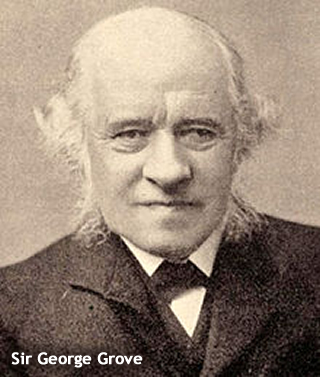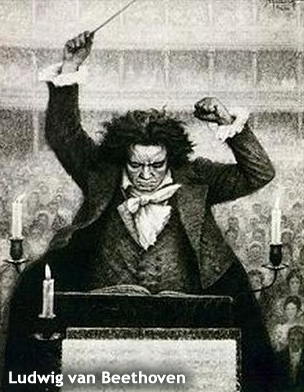 Ludwig Van Beethoven (1770-1827)
Ludwig Van Beethoven (1770-1827)
Symphony No. 4 in B-flat Major, Opus 60
Symphony No. 5 in C Minor, Opus 67
New York Philharmonic (Leonard Bernstein, conductor)
ONE-SENTENCE REVIEW:
Back from vacation – oh, yeah – and starting with one powerhouse symphony that everyone in the world can hum and one forgotten symphony that gets no respect – and, in fact, is actually hated (which is which – do you think?)… regardless, this is a classic recording not to be missed.
ORIGINAL LINER NOTES (written by Michael Danner):
Symphony No. 4 in B-flat Major, Opus 60
This symphony lies like some sunlit valley between the cragged “Eroica” and the mountainous Fifth Symphony. Beethoven composed this work in 1806 during the summer months, it is generally believed, that he spent with his friends the von Brunswicks at their estate in Hungary.
 Some musicologists – notably, Sir. George Grove – hold that the Fourth Symphony is an expression of the composer’s feelings for Countess Therese von Brunswick, to whom he was reputed to have become engaged.
Some musicologists – notably, Sir. George Grove – hold that the Fourth Symphony is an expression of the composer’s feelings for Countess Therese von Brunswick, to whom he was reputed to have become engaged.
“When writing the symphony,” said Sir George, “his heart must have been swelling with his new happiness. It is, in fact, the paean which he sings over his first conquest.
But the Fourth Symphony was not well received at its first performance, in Vienna, during the winter of 1807. One critic, admitting “wealth of ideas, bold originality and fullness of strength,” still complained of “neglect of noble simplicity” and “excessive amassing of thoughts.”
Carl Maria von Weber, then an aspiring twenty-year old musician, write a derisive article in which he had a violin claim, after a performance of the work, that it had been forced “to caper about like a wild goat” so that it could “execute the no-ideas of Mr. Composer.”
A more illuminating and sympathetic interpretation of the Symphony is left to us by Sir George Grove, who write that “a more consistent and attractive whole cannot be… The movements fit in their places like the limbs and features of a lovely statue; and, full of fire and invention as they are, all is subordinated to conciseness, grace and beauty.”
Symphony No. 5 in C Minor, Opus 67
In Berlioz’s opinion, the Symphony No. 5 was the first of Beethoven’s symphonies in which the composer “gave the reins of his vast imagination, without taking for guide or aid a foreign thought.”
 It seems to come, wrote Berlioz, “directly and solely from the genius of Beethoven; he develops in it his own intimate thought, his secret sorrows, his concentrated rage, his reveries charged with a dejection, oh, so sad, his visions at night, his bursts of enthusiasm.”
It seems to come, wrote Berlioz, “directly and solely from the genius of Beethoven; he develops in it his own intimate thought, his secret sorrows, his concentrated rage, his reveries charged with a dejection, oh, so sad, his visions at night, his bursts of enthusiasm.”
The date of the Fifth has not been definitely determined. The Symphony was begun in 1805, shortly after the completion of the “Eroica,” but it was laid aside almost at once, and Beethoven presumably did not resume work on it until 1807.
It is supposed that he completed it in that year, though it remained unplayed for another twelve months. The first performance took place in Vienna, at the Theater an der Wien, on December 22, 1808.
Concerts were concerts in those days, and the audience that heard the premiere of the Fifth also heard the Sixth Symphony and the Choral Fantasy, the Piano Concerto in G, two numbers from the Mass in C, the aria “Ah, Perfido” and an improvisation by the the composer.
Apparently the performances were deplorable, and perhaps for this reason the new works on the program were indifferently received. But the subsequent history of the Fifth was one of repeated triumphs.
 The first movement of this great work is possessed of a wild and demonic energy – “a frenetic delirium that explodes in frightful cries,” as Berlioz expressed it.
The first movement of this great work is possessed of a wild and demonic energy – “a frenetic delirium that explodes in frightful cries,” as Berlioz expressed it.
The second movement is a noble and melancholy contemplation; in form, variations on two themes.
The scherzo established a mood of mystery and terror that remind Berlioz of a sinister scene in Goethe’s Faust.
Suddenly, at the close of this movement, comes one of the greatest strokes in Beethoven, the mysterious bridge passage leading into the exultant shout that begins the finale, a glorious ascent from the darker recesses of the soul to the light of courageous, challenging life.
Note: Mr. Bernstein’s is a complete performance of the Fifth Symphony, with all repeats observed, exactly as Beethoven indicated.
TRACK LISTING:
- 1-4: Symphony No. 4 in B-flat Major, Opus 60
- 5-8: Symphony No. 5 in C Minor, Opus 67
FINAL THOUGHT:
Because Symphony No. 4 isn’t famous and we haven’t heard it a thousand times, it comes off as a little flat and boring while the Symphony No. 5, of course, does not disappoint, especially under Mr. Bernstein’s fiery baton! Classic. Classic. Classic.
 Emily Sachs – President – Manka Music Group (A division of Manka Bros. Studios – The World’s Largest Media Company)
Emily Sachs – President – Manka Music Group (A division of Manka Bros. Studios – The World’s Largest Media Company)


